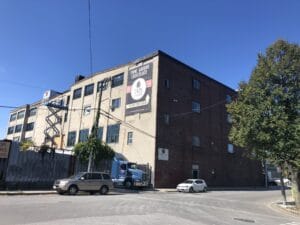
DLJ Real Estate Capital Partners is dedicating the entire 561 Windsor St. building for arts, cultural and creative tenants as part of its Boynton Yards master-planned development. Photo by Steve Adams | Banker & Tradesman Staff
A Somerville printing shop faced displacement from its 15-year home in early 2021 as its lease expiration approached and a local landlord repositioned the building to attract tech startups.
Then a New York developer paid $40 million for the 5-story converted factory, raising new questions about tenants’ future. But the new landlords, DLJ Real Estate Capital Partners and Leggat McCall Properties, notified Peter Rinnig they wanted to keep tenants such as his screen printing company and Taza Chocolate Co., while attracting more arts and makerspace tenants to 561 Windsor St. It’s rebranding the 95,000-square-foot building as “The Hive,” a metaphor for the potential cross-pollination of ideas among creative enterprises.
“They told me, ‘You’re one of the reasons we’re buying this building. Don’t go anywhere,’” said Rinnig, owner of QRST’s, which makes promotional and corporate apparel. “It was perfectly timed.”
The acquisition took place as DLJ was assembling parcels for a master-planned development including more than 1.4 million square feet of commercial space and 440 housing units. DLJ and other developers in Somerville are operating under a new set of zoning rules designed to slow the departure of the city’s arts and creative industry due to rising rents and redevelopment.
In a 2019 zoning change, commercial developers are required to set aside 5 to 10 percent of square-footage in new buildings for arts and creative enterprises (ACE). The requirement affects 22 developments under review in Somerville with potential to create 275,000 square feet for ACE tenants.
The new requirement could affect hundreds of arts and creative businesses with uncertain futures in Somerville. In a recent survey of 182 arts tenants by Metropolitan Area Planning Council, 10 percent said they are planning to leave the city. Nearly half said they rely on annual leases or informal agreements with landlords.
Ground-Floor Strategies Rethought
DLJ gave some thought to how to fit the requirement into its plans for six new buildings at its Boynton Yards project. Life science buildings are designed with mechanical equipment taking up a portion of ground floors, making it difficult to fit ACE tenants in, said John Fenton, DLJ’s managing development partner.
And in smaller developments, the square-footage created by the city’s 5 to 10 percent rule isn’t practical for many arts uses, noted Greg Jenkins, executive director of the Somerville Arts Council. Arts groups often prefer to be in a dedicated building with similar creatives, rather than as the lone non-office or lab tenant in a new commercial tower.
An alternative presented itself at the nearby 561 Windsor St. building, which DLJ had tried to acquire previously, and was successful last year in buying from Newton-based Riverside Properties.
“We thought that by acquiring this building, we could cluster the arts and creative enterprises here instead of struggling to fit 10 percent into the new buildings and without it being awkwardly placed in the middle of a lab space,” Fenton said.
As a master-planned development spanning multiple parcels totaling nearly 8 acres, Boynton Yards gives DLJ more flexibility to fulfill the 10 percent ACE requirement. Its approach: clustering existing and future tenants in the factory building.
Approximately 80 percent of the building is currently leased, including 29,000 square feet that Taza Chocolate uses for manufacturing, retail and office space. DLJ will offer rents in the under-$30 per square foot range to future arrivals, Fenton said. Rinnig agreed to reduce his square-footage from 5,000 to 2,500 square feet as part of his lease renewal last June.
“We’ve figured out a lease at a new rate, so I had to become a little smaller. DLJ was amazing in helping figure that out,” he said.
Operations, Tenant Questions Linger
Requiring developments to reserve arts space is just the first step in stabilizing the cultural economy of Somerville, the Arts Council’s Jenkins said. There’s still a challenge making connections between landlords and the arts community, in a largely overlooked niche of the commercial real estate industry.
“The city does not have a system in place yet to create bridges between the needs of the community and the developers’ space set-asides,” Jenkins said. “The question is: How does [DLJ] market them, and who gets in there? We’re trying to match people up.”
The MAPC study also suggested that Somerville offer an alternative to the blanket 5- to 10-percent requirement in new developments, in the form of in-lieu payments. That would give developers the option of contributing to a fund that acquires or stabilizes properties for ACE occupancy.

Steve Adams
Boston’s Office of Arts and Culture is sorting out many of the same issues after the city added a requirement for arts space or financial payments at developments in the South End several years ago. The requirement applies to such recent projects as the Harrison Albany multifamily development and the 321 Harrison Ave. office-lab complex, as well as future life science developments including Exchange South End and 80 East Berkeley St.
The South End is the first Boston neighborhood to be subject to the arts space requirement, and developers have not yet selected operating partners. In the meantime, the Office of Arts and Culture has issued design guidelines to developers for maximizing the use of space for various uses ranging from gallery and exhibition space to fabrication, rehearsal and performance venues.
“We know that build outs and operating plans are a key area that needs more attention,” said Melissa Meyer, the office’s cultural planning project manager, in an email.
Editor’s note: This story has been updated to include Leggat McCall Properties’ ownership position at Boynton Yards.




 |
| 
